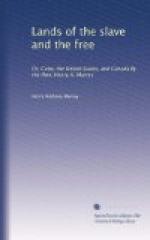Among other proposed improvements is one to transmit the signature of individuals, maps and plans, and even the outlines of the human face, so as to aid in the apprehension of rogues, &c. By a table of precedence, Government messages, and messages for the furtherance of justice and detection of criminals, are first attended to; then follow notices of death, or calls to a dying bed; after which, is the Press, if the news be important; if not, it takes its turn with the general, commercial, and other news. The wires in America scorn the railway apron-strings in which they are led about in this country. They thread their independent course through forests, along highways and byways, through streets, over roofs of houses,—everybody welcomes them,—appearance bows down at the shrine of utility, and in the smallest villages these winged messengers are seen dropping their communicative wires into the post-office, or into some grocer’s shop where a ’cute lad picks up all the passing information—which is not in cypher—and probably retails it with an amount of compound interest commensurate with the trouble he has taken to obtain it. There is no doubt that many of these village stations are not sure means of communication, partly perhaps from carelessness, and partly from the trunk arteries having more important matter to transmit, and elbowing their weaker neighbours out of the field. Their gradual increase is, however, a sufficient proof that the population find them useful, despite the disadvantages they labour under. In some instances, they have shown a zeal without discretion, for a friend of mine, lately arrived from the Far West, informs me, that in many places the wires may be seen broken, and the poles tumbling down for miles and miles together, the use of the telegraph not being sufficient even to pay for the keeping up. This fact should be borne in mind when we give them the full benefit of the 16,735 miles according to their own statement in The Seventh Census.
The very low tariff of charge renders the use of the telegraph universal throughout the Union. In Messrs. Whitworth’s and Wallis’s report, they mention an instance of a manufacturer in New York, who had his office in one part of the town and his works in an opposite direction, and who, to keep up a direct communication between the two, erected a telegraph at his own expense, obtaining leave to carry it along over the tops of the intervening houses without any difficulty. The tariff alluded to above will of course vary according to the extent of the useful pressure of competition. I subjoin two of their charges as an example. From Washington to Baltimore is forty miles, and the charge is 10d. for ten words. From New York to New Orleans is two thousand miles, and the charge for ten words is ten shillings. It must be remembered that these ten words are exclusive of the names and addresses of the parties sending and receiving the message.




